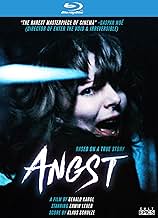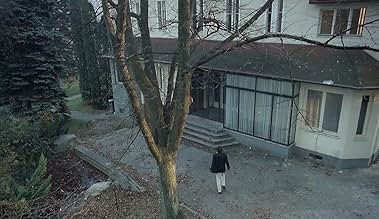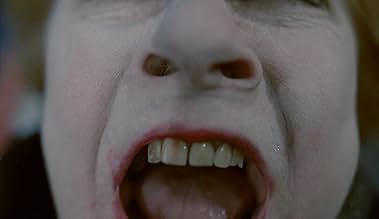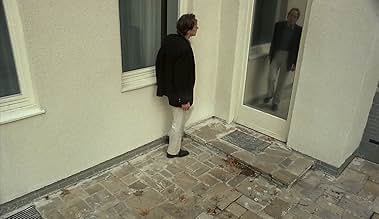AVALIAÇÃO DA IMDb
7,2/10
15 mil
SUA AVALIAÇÃO
Um homem perturbado é libertado da prisão e começa a jogar suas fantasias sádicas sobre uma família que vive em uma casa isolada.Um homem perturbado é libertado da prisão e começa a jogar suas fantasias sádicas sobre uma família que vive em uma casa isolada.Um homem perturbado é libertado da prisão e começa a jogar suas fantasias sádicas sobre uma família que vive em uma casa isolada.
- Direção
- Roteiristas
- Artistas
Robert Hunger-Bühler
- Off-Text
- (narração)
Silvia Ryder
- Daughter (Silvia)
- (as Silvia Rabenreither)
Karin Springer
- Daughter
- (narração)
Josefine Lakatha
- Mother
- (narração)
Helmut Hrdina
- Prison Guard
- (as Major Helmut Hrdina)
- Direção
- Roteiristas
- Elenco e equipe completos
- Produção, bilheteria e muito mais no IMDbPro
Avaliações em destaque
I have always been a fan of the genre of serial killer movies. Not to get confused with slasher flicks because the serial killer movies are usually sophisticated with a realistic feel to them, causing an unnerving and disturbing feel. Not to take away from the slasher because there is fun in those movies. Angst is the best of the serial killer movies, in my personal opinion. Henry: Portrait of a Serial Killer is marvelous and Amoklauf is also a great film, but as far as putting you right in the serial killers mind, this movie does the best and it is very frightening.
The story starts with the lead character (basically the only lead character) walking up to a house. He knocks on the door and when the door opens he murders the person who answers with a hand gun. After being in jail for 10 years he is released. Upon his release he instantly gets started again murdering a mother and her grown children. One of which a retarded man in a wheelchair.
The storyline may seem simple but in no means is the character simple. After he murders the person at the beginning of the movie we are shown events in documentary form leading up to the murder and him going into jail. So we become familiar with the character. But being familiar with the character and suddenly being put in the characters shoes are two different things.
The whole movie when he is released from jail is narrated by the killer, almost like he is thinking and we can hear his thoughts. When he goes into a restaurant and sits down at the table he starts getting uncomfortable after watching two young woman sitting at the bar. He starts thinking of sick things to do to them and as a result gets the feeling that everyone in the restaurant is watching him. So right away we, as the audience, get this uncomfortable feeling as well and we are also introduced to how paranoid the character is. Much of the movie is like this.
The moments in which he is murdering the family is almost unbearable and rather disturbing. I don't want to give to much away but be prepared to be disturbed. It's not the violent nature in which he kills these people it's almost the inevitable lead up to it.
Well, I hope this review helps. This is a very difficult film to find so good luck in the search. Sources from IMDb tell me that this will be released in the states eventually. If you find it before then... enjoy. 10/10
The story starts with the lead character (basically the only lead character) walking up to a house. He knocks on the door and when the door opens he murders the person who answers with a hand gun. After being in jail for 10 years he is released. Upon his release he instantly gets started again murdering a mother and her grown children. One of which a retarded man in a wheelchair.
The storyline may seem simple but in no means is the character simple. After he murders the person at the beginning of the movie we are shown events in documentary form leading up to the murder and him going into jail. So we become familiar with the character. But being familiar with the character and suddenly being put in the characters shoes are two different things.
The whole movie when he is released from jail is narrated by the killer, almost like he is thinking and we can hear his thoughts. When he goes into a restaurant and sits down at the table he starts getting uncomfortable after watching two young woman sitting at the bar. He starts thinking of sick things to do to them and as a result gets the feeling that everyone in the restaurant is watching him. So right away we, as the audience, get this uncomfortable feeling as well and we are also introduced to how paranoid the character is. Much of the movie is like this.
The moments in which he is murdering the family is almost unbearable and rather disturbing. I don't want to give to much away but be prepared to be disturbed. It's not the violent nature in which he kills these people it's almost the inevitable lead up to it.
Well, I hope this review helps. This is a very difficult film to find so good luck in the search. Sources from IMDb tell me that this will be released in the states eventually. If you find it before then... enjoy. 10/10
Word on the street is this is a super intense, gruelling, claustrophobic serial killer film. They're not lying. But it's important to get to note why, especially in this case: why this type of violence enthralls so much? And I mean apart from any particular on-screen nastiness. More virulent films have been made, much nastier. Why this fascinates is a completely different beast than say, something like Hostel.
It's the easiest thing to make us cringe and shy away, but to fervently want to keep watching?
The popular opinion is this works so well exactly because of how contained and straight-forward. There are no distractions from the concentrated moment we first encounter: a inmate giving himself a shave on his day of parole. There are no allusions to anything else but private madness and nothing to escape to for comfort or respite, except perhaps sheer exhaustion. This man is going to go on a crime spree again as soon as he's out of prison, we can tell this much. We can tell it's going to unravel the way we secretly hope it does.
Well, this is fine and makes some sense. But doesn't adequately explain to my mind. No, why this works so viscerally - and ties in with other interests of mine in film - I believe has all to do with the cinematic eye.
Now most films operate on the assumption that you want to experience a world as real as possible. Every advance in cinematic technology - sound, color, the recent fad of 3D - is a step in that direction. We want to escape more vividly and more urgently than ever. And what most films do to abet that escape is to let loose a few threads of story and place, hopefully open enough if we are in caring hands, that we can be trusted to attach ourselves from own experience. The tighter the weave of the threads from that point on, the closer we are lassoed to the cinematic world. Editing and camera are assigned invisible ways; they have to work without us getting to notice.
The Soviets changed all that very early in the game. Here a very world was assembled by the eye. There was no story, it was all a matter of calligraphic (dynamic overlapping) watching. Welles, and less famously Sternberg before him, unpacked these notions by letting it fall on the eye of the camera to join fragments together.
(this particular eye was first conceived by the Buddhist but that's another story altogether).
Now this is rumored to be the DP's project working under an alias, a Polish man who knows the camera. The opening shot exhibits masterful knowledge of Welles; a crane shot that establishes location by joining together many different planes of perspective. It would have been a film to watch with just this mode, that others like Argento and DePalma exercised in adventurous flourishes of spatial exploration.
It's actually a little more elaborate than that. We have two eyes instead of the one. The first is the killer's eye, tightly screwed and always at eye-level as he prowls around. Interior monologue plays out in voice-over, itself taken from the diaries of an actual killer, and meant to recast everything as internal space: victims are an invalid, an old woman and her daughter, each one mapping to a person that deeply wounded in the past as we find out. So we have exceedingly tormented soul spilled out and contorting physical space, very much like Zulawski practiced. Another Pole, another piece of the puzzle.
The second eye you will notice is always mounted on a crane and pulled upwards in steep ascends. A bird's eye far removed from human madness, which is the Buddhist eye of woodblock prints. To the film's credit, and this is a lot of its power for me, it remains abstract enough that we may use this perspective as we are inclined: is it a godless and uncaring or a merciful eye, pulling us from the carnage or skipping to the next?
It's the easiest thing to make us cringe and shy away, but to fervently want to keep watching?
The popular opinion is this works so well exactly because of how contained and straight-forward. There are no distractions from the concentrated moment we first encounter: a inmate giving himself a shave on his day of parole. There are no allusions to anything else but private madness and nothing to escape to for comfort or respite, except perhaps sheer exhaustion. This man is going to go on a crime spree again as soon as he's out of prison, we can tell this much. We can tell it's going to unravel the way we secretly hope it does.
Well, this is fine and makes some sense. But doesn't adequately explain to my mind. No, why this works so viscerally - and ties in with other interests of mine in film - I believe has all to do with the cinematic eye.
Now most films operate on the assumption that you want to experience a world as real as possible. Every advance in cinematic technology - sound, color, the recent fad of 3D - is a step in that direction. We want to escape more vividly and more urgently than ever. And what most films do to abet that escape is to let loose a few threads of story and place, hopefully open enough if we are in caring hands, that we can be trusted to attach ourselves from own experience. The tighter the weave of the threads from that point on, the closer we are lassoed to the cinematic world. Editing and camera are assigned invisible ways; they have to work without us getting to notice.
The Soviets changed all that very early in the game. Here a very world was assembled by the eye. There was no story, it was all a matter of calligraphic (dynamic overlapping) watching. Welles, and less famously Sternberg before him, unpacked these notions by letting it fall on the eye of the camera to join fragments together.
(this particular eye was first conceived by the Buddhist but that's another story altogether).
Now this is rumored to be the DP's project working under an alias, a Polish man who knows the camera. The opening shot exhibits masterful knowledge of Welles; a crane shot that establishes location by joining together many different planes of perspective. It would have been a film to watch with just this mode, that others like Argento and DePalma exercised in adventurous flourishes of spatial exploration.
It's actually a little more elaborate than that. We have two eyes instead of the one. The first is the killer's eye, tightly screwed and always at eye-level as he prowls around. Interior monologue plays out in voice-over, itself taken from the diaries of an actual killer, and meant to recast everything as internal space: victims are an invalid, an old woman and her daughter, each one mapping to a person that deeply wounded in the past as we find out. So we have exceedingly tormented soul spilled out and contorting physical space, very much like Zulawski practiced. Another Pole, another piece of the puzzle.
The second eye you will notice is always mounted on a crane and pulled upwards in steep ascends. A bird's eye far removed from human madness, which is the Buddhist eye of woodblock prints. To the film's credit, and this is a lot of its power for me, it remains abstract enough that we may use this perspective as we are inclined: is it a godless and uncaring or a merciful eye, pulling us from the carnage or skipping to the next?
Great camerawork and an unsettling sense of dread are the two main reasons to recommend Angst. It's an ugly and uncomfortable film, but one made with lots of skill. It's emotionally cold and a depressing experience, but an unforgettable one nevertheless. You might want to save it for when you're in the right mood, because it's bound to disturb the rest of your day.
Angst is without a doubt one of the best serial killer flicks in the history of cinema. And some would say The Best. And I can tell you, it's damn close.
Angst follows a serial killer who is released from prison after a 10 year incarceration. What takes place is shocking and original film-making. What this man does is just start up where he left off. It's basically just following around the killer and just getting to know him. Oh and his victims, but in a more or less personal way. Eesh.
Angst excels in all facets. The acting by the main character, the serial killer, is flat out great, in an insane sort of way. He looks the part, and definitely acts the part. The scene when he's in the car is unforgettable. Throw in great cinematography, direction and writing, and the fact that this is a truly disturbing, realistic look into a serial killer's obsessive habits, it easily makes this one of the best serial killer movies of all time.
Angst follows a serial killer who is released from prison after a 10 year incarceration. What takes place is shocking and original film-making. What this man does is just start up where he left off. It's basically just following around the killer and just getting to know him. Oh and his victims, but in a more or less personal way. Eesh.
Angst excels in all facets. The acting by the main character, the serial killer, is flat out great, in an insane sort of way. He looks the part, and definitely acts the part. The scene when he's in the car is unforgettable. Throw in great cinematography, direction and writing, and the fact that this is a truly disturbing, realistic look into a serial killer's obsessive habits, it easily makes this one of the best serial killer movies of all time.
Well there certainly aren't a lot of movies like this one! I've been looking forward to a viewing of Angst for some time now, and now that it's finally come, I have to say that the film didn't disappoint! Unlike many films of this nature, this one truly is horrendously disturbing and the original way that it goes about portraying the mind of a serial killer has ensured the film its cult status. The obvious film to compare this one to would be the 1986 film 'Henry: Portrait of a Serial Killer', but although they share some themes - the two can never really be compared, Angst feels a whole lot more real! The plot itself is very simple and there isn't really any story to it. The film simply follows a man upon his release from prison. We are immediately made aware that he is a psychopath through his musings and the way that his first plan upon release is to go back to his old murderous ways. First, he decides to murder a taxi driver; but that plan goes wrong when he bottles it at the last moment. Later, he happens upon a secluded house and decides to have some fun with the occupants...
The best thing about this film is the way that it mixes the killer's sadistic monologues with the action on screen. We get to see him torturing his victims, and at the same time he's giving us a run down of past events in his life and his desires, and this really makes us feel like we're getting inside the psychopath's head. The film is lead by Erwin Leder, who gives an absolutely great performance in the central role! He both looks the part and sounds the part of the psychopath he's portraying, and much of the success of the film is courtesy of him. The film is completely disturbing, but it doesn't deliver this with shocks in the way that many movies do - Angst is not a gory film, but it's more shocking than any amount of gore because of the way that it presents itself. The realism of the piece, together with disorientating camera work, the piercing soundtrack and the aforementioned voice over ensure that this is not an 'easy' film to sit through. However, if you're looking for a sadistic shocker that really does do what it says on the tin - then good luck tracking down a copy of Angst!
The best thing about this film is the way that it mixes the killer's sadistic monologues with the action on screen. We get to see him torturing his victims, and at the same time he's giving us a run down of past events in his life and his desires, and this really makes us feel like we're getting inside the psychopath's head. The film is lead by Erwin Leder, who gives an absolutely great performance in the central role! He both looks the part and sounds the part of the psychopath he's portraying, and much of the success of the film is courtesy of him. The film is completely disturbing, but it doesn't deliver this with shocks in the way that many movies do - Angst is not a gory film, but it's more shocking than any amount of gore because of the way that it presents itself. The realism of the piece, together with disorientating camera work, the piercing soundtrack and the aforementioned voice over ensure that this is not an 'easy' film to sit through. However, if you're looking for a sadistic shocker that really does do what it says on the tin - then good luck tracking down a copy of Angst!
Você sabia?
- CuriosidadesPig's blood, not stage blood, was used for the stabbing scene, for the sake of additional realism.
- Erros de gravaçãoWhen the daughter picks up the knife with her mouth it suddenly has changed into an upright position.
- Citações
[first lines]
The Psychopath: The fear in her eyes and the knife in the chest. That's my last memory of my mother. That's why I had to go to prison for four years, even though she survived.
- Versões alternativasTwo versions of the film exist, the 87-minute version originally released to theatres and a 79-minute version that would be considered the director's cut. The longer version includes a prologue that was added by director Gerald Kargl in response to theatrical distributors who felt the film was too short. It includes a brief murder scene of K's first victims and a narrator recalling details of the man's youth, details which are mostly redundant with some of the narrative reflection later in the film. The shorter version, known as Kargl's preferred version, eliminates those eight minutes entirely.
- ConexõesEdited into Erwin Leder in Fear (2015)
Principais escolhas
Faça login para avaliar e ver a lista de recomendações personalizadas
Detalhes
- Data de lançamento
- País de origem
- Centrais de atendimento oficiais
- Idioma
- Também conhecido como
- Angst
- Locações de filme
- Waldgasse 1, 2371 Hinterbrühl, Áustria(House and most exteriors)
- Empresa de produção
- Consulte mais créditos da empresa na IMDbPro
Bilheteria
- Orçamento
- € 400.000 (estimativa)
Contribua para esta página
Sugerir uma alteração ou adicionar conteúdo ausente



























